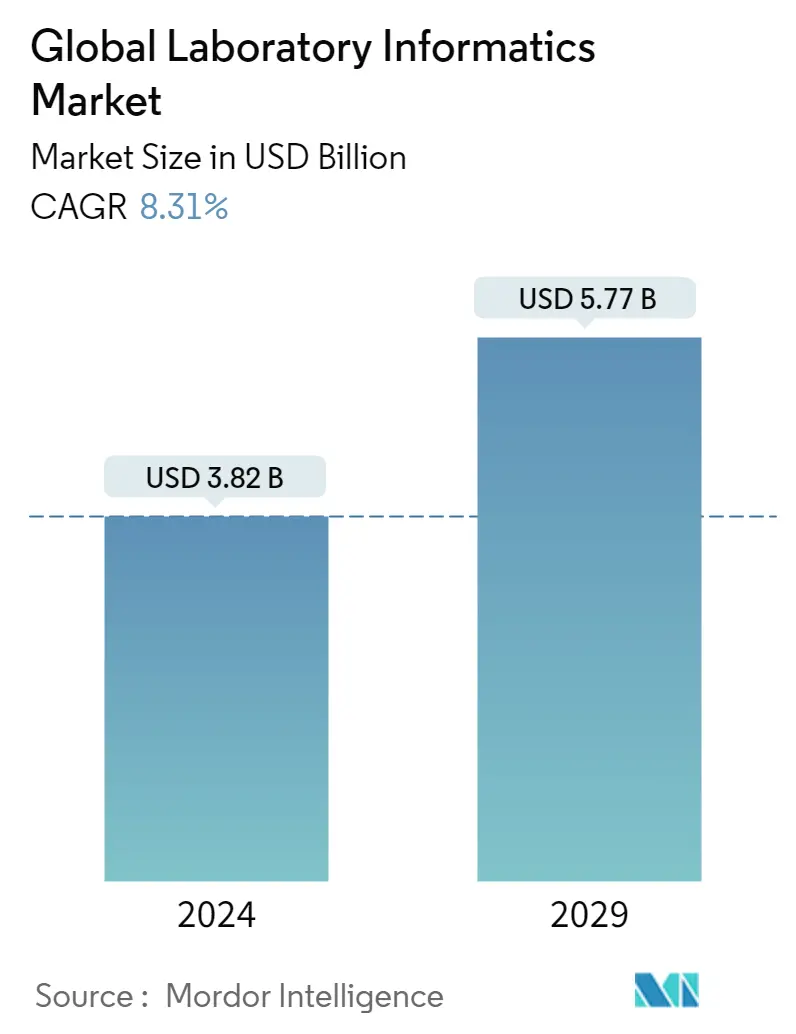Market Size of Global Laboratory Informatics Industry

| Study Period | 2019 - 2029 |
| Market Size (2024) | USD 3.82 Billion |
| Market Size (2029) | USD 5.77 Billion |
| CAGR (2024 - 2029) | 8.31 % |
| Fastest Growing Market | Asia Pacific |
| Largest Market | North America |
Major Players
*Disclaimer: Major Players sorted in no particular order |
Laboratory Informatics Market Analysis
The Global Laboratory Informatics Market size is estimated at USD 3.82 billion in 2024, and is expected to reach USD 5.77 billion by 2029, growing at a CAGR of 8.31% during the forecast period (2024-2029).
Augmented reality (AR), artificial intelligence (AI), and virtual reality (VR) solutions are anticipated to contribute substantially, while responding to the COVID-19 pandemic and address continuously evolving challenges. Due to the epidemic outbreak, the existing situation may inspire pharmaceutical vendors and healthcare establishments to improve their R&D investments in AI, acting as a core technology for enabling various initiatives.
COVID-19 has the highest impact on the market as the pandemic has forced the government and agencies to develop and launch the COVID-19 vaccine to control the severity in cases. Thus, the demand for an optimized approach example, the United States Food and Drug Administration ICH-Good Clinical Practice R2, has been amended as per clinical drug development and fast-tracking and monitoring risk during trials and found to be an important tool in COVID-19 drug development status tracking.
Moreover, factors driving the market include high accuracy and efficiency of results, increasing applications of lab informatics solutions, and the increasing number of diagnoses.
Owing to the increased workload, cost constraints, and advancements in technologies, the nature of pathology is rapidly changing, as per the need of the market. New laboratory systems are manufactured with the best technologies to alleviate the current global demand. New approaches for managing laboratory information are now required to fulfill the changing requirements of the healthcare system. The primary concern for clinicians is the accuracy of the information that they get through various resources. However, according to an article 'Making Healthcare Safer III: A Critical Analysis of Existing and Emerging Patient Safety Practices' published in March 2020, the prevalence of diagnostic error is 5% in adults being affected in the outpatient environment and 6 to 17% in hospital admission. Thus, to avoid these diagnostic errors and to provide better services, clinics and laboratories are implementing various tools, such as laboratory information systems (LIS) and LIMS.
Moreover, The laboratory information systems provide flexibility in terms of user interface like Abbott Healthcare LIMS platform STARLIMS can be operated through mobile application with the help of such tools, laboratory operations, including the diagnostic tests, have become much easier. The management of the laboratory data and progress in the laboratory workflow is achieved with the help of laboratory informatics tools, and high accuracy is provided. Hence, laboratory informatics ultimately improves the overall efficiency of the laboratories.
The LIMS improves the sampling of data that involves different laboratories and aids in integrating research information. According to an article published by Gorden feller in July 2020, it was reported that SciCord offers an electronic lab notebook (ELN)/LIMS solution is a digital replacement for paper notebooks, and there was a 30% increase in productivity in adoption, which was adopted by more than 6,000 scientists. Additionally, the rising efforts of clinicians and pathologists to provide the best and error-free results are contributing to the increasing demand for laboratory informatics products and services, which is further influencing the market in a positive manner.
However, the lack of integration standards for laboratory informatics and the lack of skilled professionals are restraining the overall market growth.
Laboratory Informatics Industry Segmentation
As per the scope of this report, laboratory informatics is the specialized application of information with the help of a platform consisting of equipment, software, and data management tools that allow scientific data to be captured, migrated, processed, and interpreted for immediate use, as well as for future use.
The laboratory informatics market is segmented by product (laboratory information management system (LIMS), electronic lab notebooks (ELN), enterprise content management (ECM), laboratory execution system (LES), chromatography data system (CDS), scientific data management system (SDMS), and electronic data capture (EDC) and clinical data management systems (CDMS)), component (services and software), delivery mode (on-premise, web-hosted, and cloud-based), and geography (North America, Europe, Asia Pacific, Middle-East and Africa, and South America). The market report also covers the estimated market sizes and trends for 17 different countries across major regions, globally. The report offers the value (in USD million) for the above segments.
| By Product | |
| Laboratory Information Management System (LIMS) | |
| Electronic Lab Notebooks (ELN) | |
| Enterprise Content Management (ECM) | |
| Laboratory Execution System (LES) | |
| Chromatography Data System (CDS) | |
| Scientific Data Management System (SDMS) | |
| Electronic Data Capture (EDC) and Clinical Data Management Systems (CDMS) |
| By Component | |
| Services | |
| Software |
| By Delivery Mode | |
| On-premise | |
| Web-hosted | |
| Cloud-based |
| By Geography | ||||||||
| ||||||||
| ||||||||
| ||||||||
| ||||||||
|
Global Laboratory Informatics Market Size Summary
The laboratory informatics market is poised for significant growth, driven by advancements in technologies such as augmented reality, artificial intelligence, and virtual reality. These technologies are expected to play a crucial role in addressing the challenges posed by the COVID-19 pandemic, prompting increased investments in research and development within the pharmaceutical and healthcare sectors. The pandemic has underscored the importance of optimized approaches in clinical drug development, leading to the adoption of tools like laboratory information systems (LIS) and laboratory information management systems (LIMS) to enhance accuracy and efficiency in laboratory operations. These systems are becoming essential in managing the growing workload and cost constraints, as well as in improving diagnostic accuracy, thereby reducing diagnostic errors and enhancing patient care.
The market is characterized by a competitive landscape with major players such as Abbott Laboratories, Agilent Technologies, McKesson Corporation, and Thermo Fisher Scientific Inc. holding substantial market shares. The United States, being the most affected by COVID-19, has seen a surge in the adoption of digital information systems to streamline healthcare processes and improve data sharing. North America currently dominates the market, supported by a well-established healthcare industry and favorable reimbursement facilities. The increasing geriatric population and lifestyle disorders in the region are further driving the demand for laboratory tests. Companies are actively launching new products and services to enhance their market presence, with a focus on integrating advanced analytics and cloud technologies to improve laboratory efficiencies and support public health initiatives.
Global Laboratory Informatics Market Size - Table of Contents
-
1. MARKET DYNAMICS
-
1.1 Market Overview
-
1.2 Market Drivers
-
1.2.1 High Accuracy and Efficiency of Results
-
1.2.2 Increasing Applications of Lab Informatics Solutions
-
1.2.3 Increasing Number of Diagnoses
-
-
1.3 Market Restraints
-
1.3.1 Lack of Integration Standards for Laboratory Informatics
-
1.3.2 Lack of Skilled Professionals
-
-
1.4 Industry Attractiveness - Porter's Five Forces Analysis
-
1.4.1 Bargaining Power of Buyers/Consumers
-
1.4.2 Bargaining Power of Suppliers
-
1.4.3 Threat of New Entrants
-
1.4.4 Threat of Substitute Products
-
1.4.5 Intensity of Competitive Rivalry
-
-
-
2. MARKET SEGMENTATION (Market Size by Value - USD Million)
-
2.1 By Product
-
2.1.1 Laboratory Information Management System (LIMS)
-
2.1.2 Electronic Lab Notebooks (ELN)
-
2.1.3 Enterprise Content Management (ECM)
-
2.1.4 Laboratory Execution System (LES)
-
2.1.5 Chromatography Data System (CDS)
-
2.1.6 Scientific Data Management System (SDMS)
-
2.1.7 Electronic Data Capture (EDC) and Clinical Data Management Systems (CDMS)
-
-
2.2 By Component
-
2.2.1 Services
-
2.2.2 Software
-
-
2.3 By Delivery Mode
-
2.3.1 On-premise
-
2.3.2 Web-hosted
-
2.3.3 Cloud-based
-
-
2.4 By Geography
-
2.4.1 North America
-
2.4.1.1 United States
-
2.4.1.2 Canada
-
2.4.1.3 Mexico
-
-
2.4.2 Europe
-
2.4.2.1 Germany
-
2.4.2.2 United Kingdom
-
2.4.2.3 France
-
2.4.2.4 Italy
-
2.4.2.5 Spain
-
2.4.2.6 Rest of Europe
-
-
2.4.3 Asia Pacific
-
2.4.3.1 China
-
2.4.3.2 Japan
-
2.4.3.3 India
-
2.4.3.4 Australia
-
2.4.3.5 South Korea
-
2.4.3.6 Rest of Asia Pacific
-
-
2.4.4 Middle-East and Africa
-
2.4.4.1 GCC
-
2.4.4.2 South Africa
-
2.4.4.3 Rest of Middle-East and Africa
-
-
2.4.5 South America
-
2.4.5.1 Brazil
-
2.4.5.2 Argentina
-
2.4.5.3 Rest of South America
-
-
-
Global Laboratory Informatics Market Size FAQs
How big is the Global Laboratory Informatics Market?
The Global Laboratory Informatics Market size is expected to reach USD 3.82 billion in 2024 and grow at a CAGR of 8.31% to reach USD 5.77 billion by 2029.
What is the current Global Laboratory Informatics Market size?
In 2024, the Global Laboratory Informatics Market size is expected to reach USD 3.82 billion.

